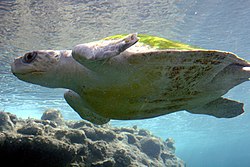| Eochelone Temporal range: | |
|---|---|
| Scientific classification | |
| Domain: | Eukaryota |
| Kingdom: | Animalia |
| Phylum: | Chordata |
| Class: | Reptilia |
| Order: | Testudines |
| Suborder: | Cryptodira |
| Superfamily: | Chelonioidea |
| Family: | Cheloniidae |
| Genus: | † Eochelone Dollo, 1903 |
| Type species | |
| † Eochelone brabantica | |
| Species | |
Eochelone is an extinct genus of sea turtle from the late Eocene. It was first named by Dollo in 1903. Its type species is E. brabantica.
